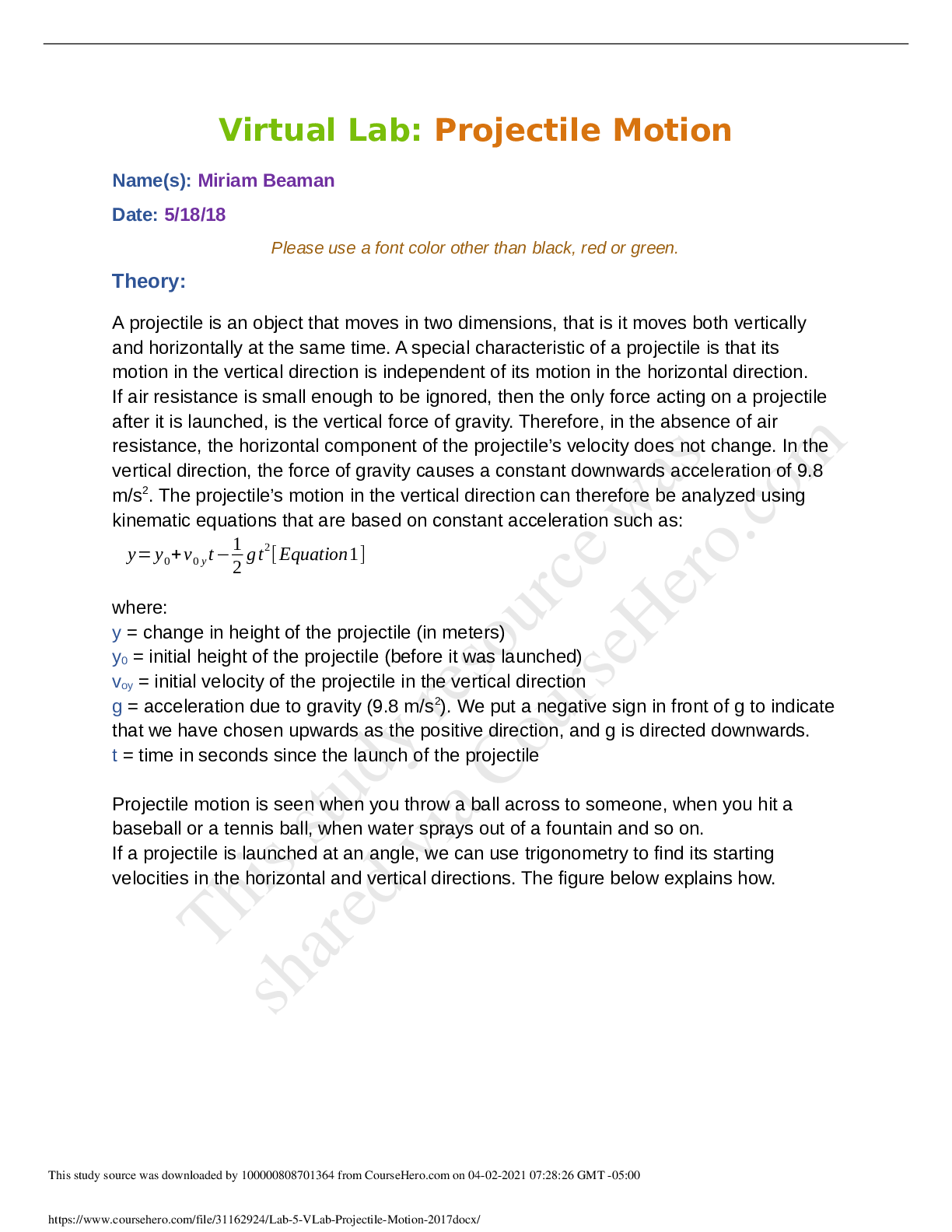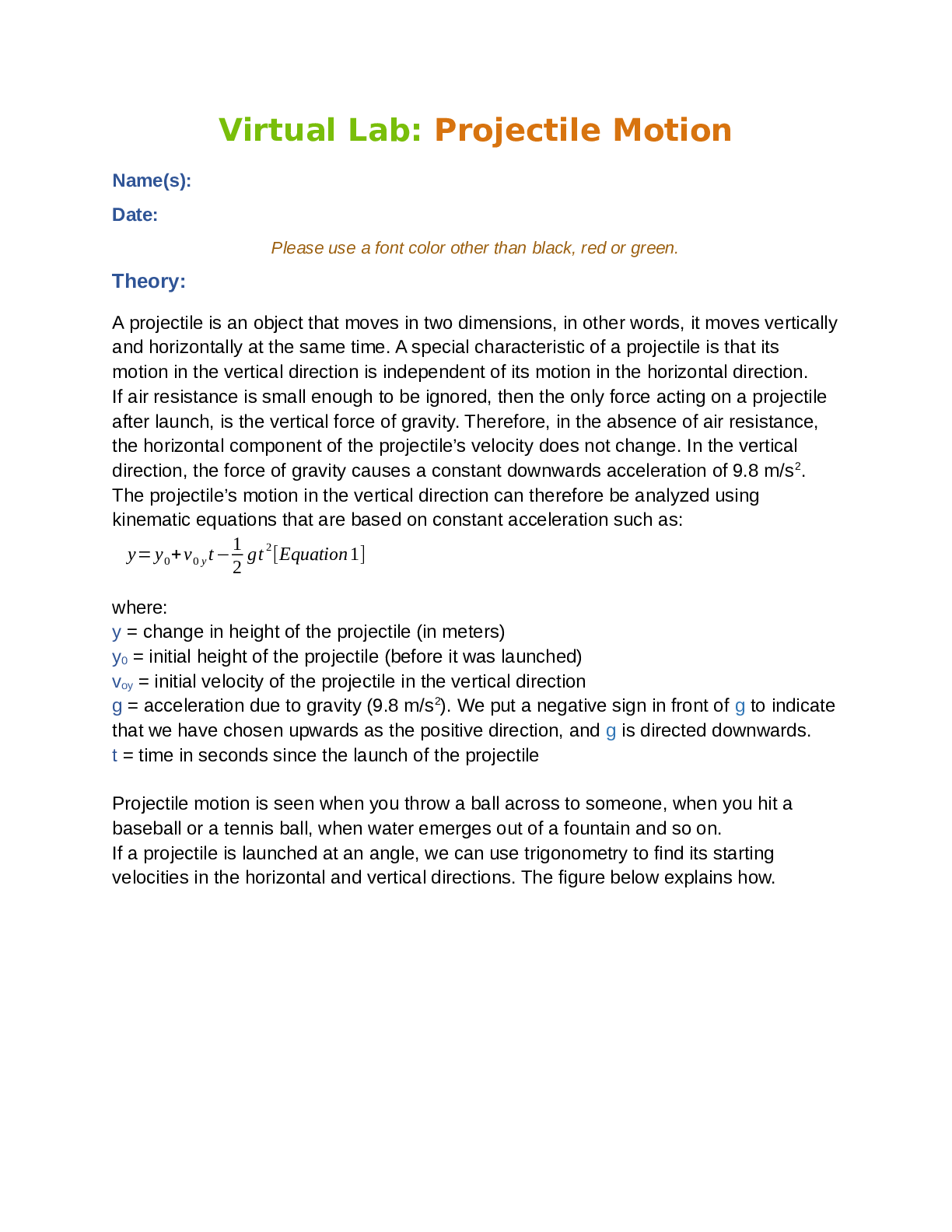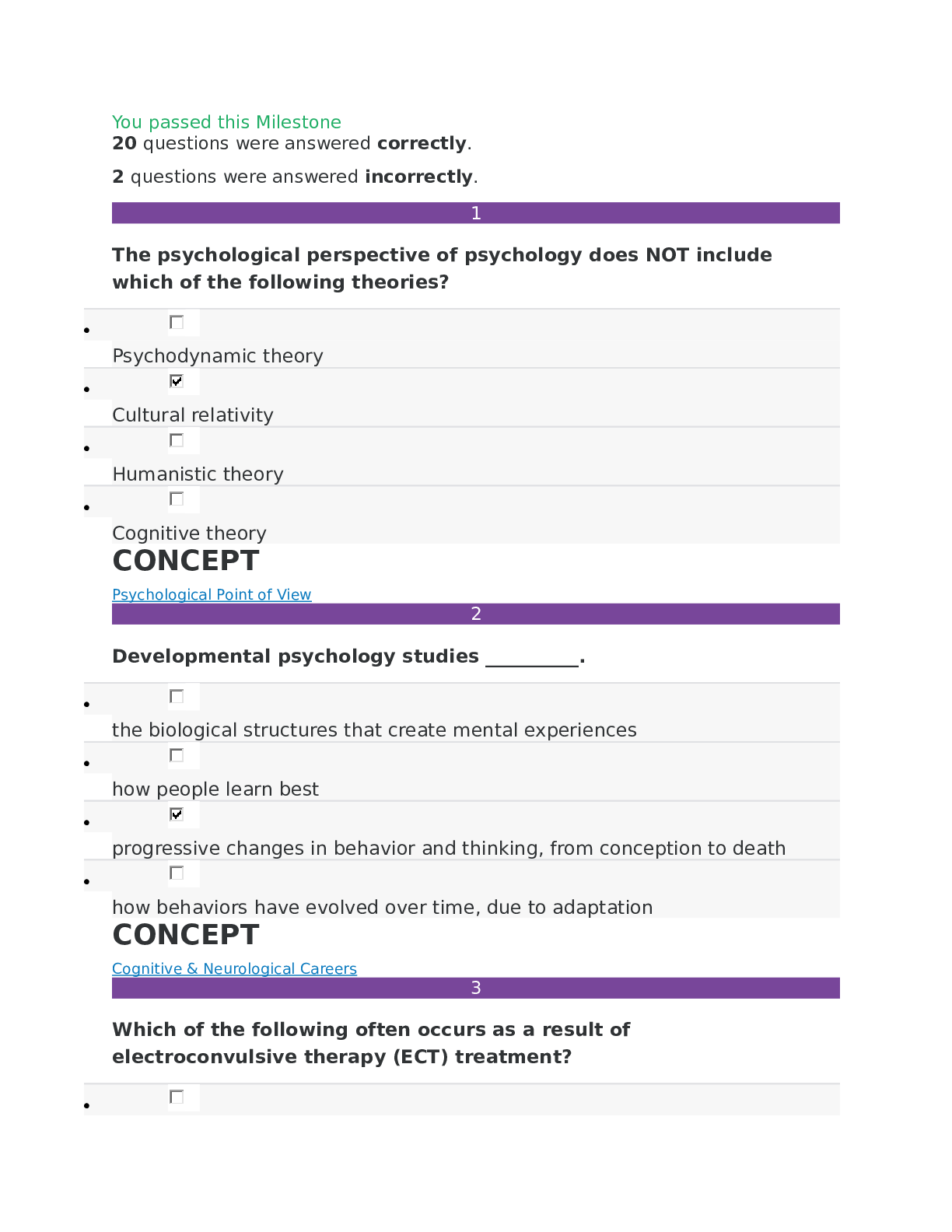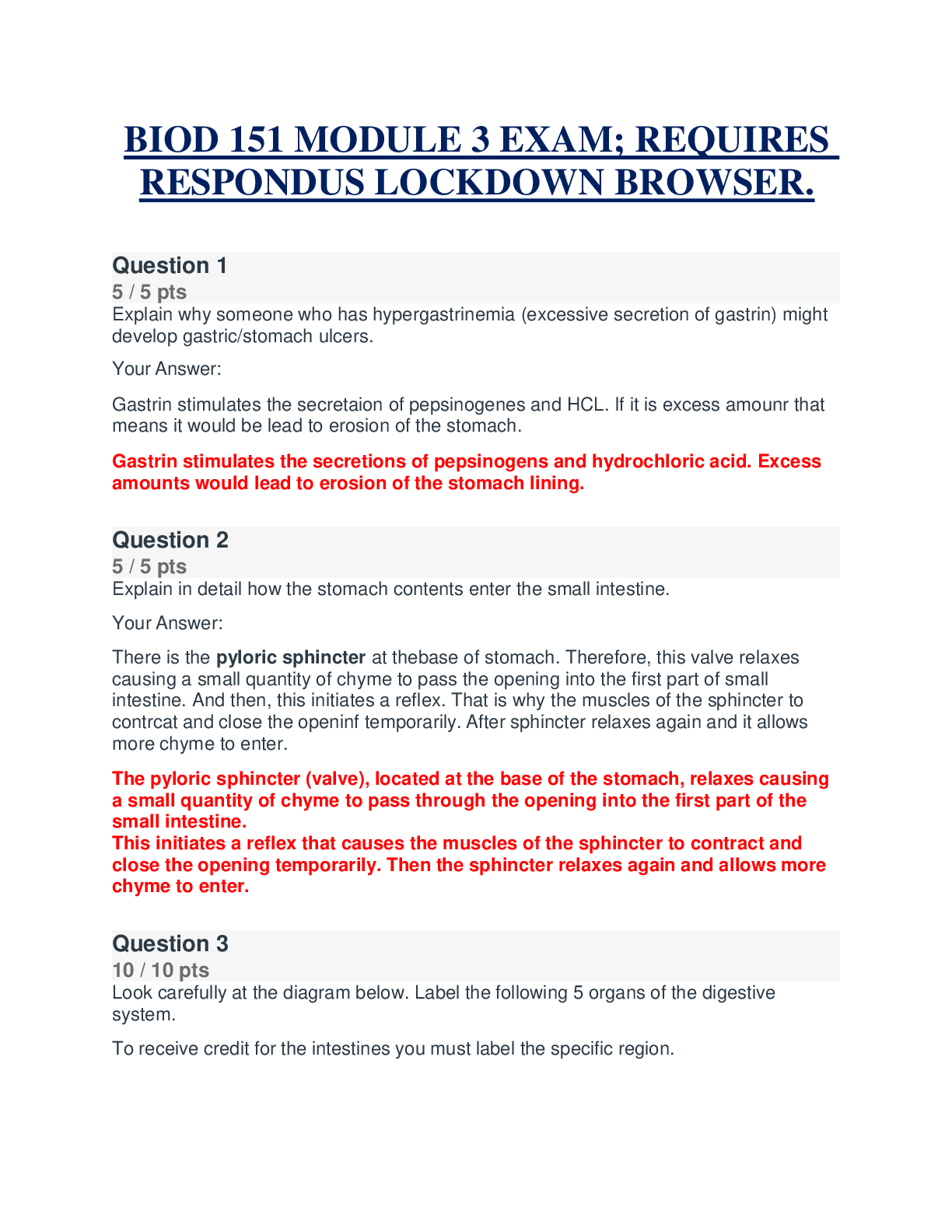Exam-NURSING 101 MODULE 3 EXAM; COMPLETE SOLUTIONS. (2020-2021)
Document Content and Description Below
The mother of a 3-year-old child tells the nurse that her child hit her doll after the mother scolded her for picking the neighbors’ flowers. Which defense mechanism used by the child does the nurse... identify in the mother’s report? · Displacement Correct · Sublimation · Identification · Projection Rationale: The defense mechanism of displacement involves the discharge of intense feelings for one person onto a substitute person or object that is less threatening to satisfy an impulse. Projection involves attributing an attitude, behavior, or impulse, such as that which occurs in blaming or scapegoating, to someone else. Sublimation is the act of rechanneling an impulse into a more socially acceptable object. Identification involves modeling behavior after someone else's. 2.ID: 6 A client says to the nurse, “I’ve been following my diet and taking my medication. What else do you want to talk about today?” Which response would be most helpful during the working phase of the therapeutic alliance? · “Some people have added exercise to diet and medication therapy and gotten positive results. Do you think that this would work for you?” Correct · “Sounds fine to me. Let’s meet again in 6 months.” · “Well, you’ve talked about diet in your terms, but perhaps I should test you on specific things.” · “I don’t believe that you have been following your diet, because you haven’t lost any weight.” Rationale: Although suggestion or overt giving of advice is sometimes nontherapeutic, these strategies are therapeutic when used in the working phase, because in this situation they will increase the client’s perception of all available options in the treatment plan. Answering, “Sounds fine to me. Let’s meet again in 6 months” stops the communication process. Stating to the client that he or she has not lost any weight implies disbelief and does not explore the reasons for the client’s failure to lose weight. “Testing” challenges the client and is nontherapeutic. Test-Taking Strategy: Note the strategic word “most” and remember therapeutic communication techniques. Noting the words “working phase” in the question will direct you to the correct option. Review: therapeutic communication techniques . 3.ID: 8 As the nurse prepares to interview a client being admitted to the mental health unit, the client says, “I asked my family to bring me in here to talk to someone, but now I don’t know where to begin.” Which response by the nurse would be most helpful? · “Perhaps you can start by sharing some of your most recent concerns.” Correct · “Don’t worry. Everyone who comes in here for the first time feels reluctant to talk.” · “Why not just start talking and see where it takes you?” · “If I were you, I’d begin with what you were doing this morning.” Rationale: The intake interview is usually the first contact with the client. It is intended to establish rapport, to help the nurse understand the client’s current problem and level of functioning, and to help the nurse formulate a nursing care plan. The clinician usually allows the client to set the pace of the interview and uses open-ended questions to elicit a comprehensive diagnostic picture of the client’s problems and level of coping. Sharing concerns is a good place to start the conversation, because it will allow the client to express feelings. The response “Why not just start talking and see where it takes you?” is too general and does not provide the client with a focus on self. Telling the client not to worry is nontherapeutic and avoids addressing the client’s concerns. Test-Taking Strategy: Note the strategic word “most.” Use your knowledge of therapeutic communication techniques. Focusing on the client’s feelings will direct you to the correct option. Review: therapeutic communication techniques . 4.ID: 0 During a mental health intake interview, a young adult client who lives with his family rent free says, “I’m tired of not being able to offer my friends a beer just because my folks don’t believe in taking a drink socially.” Which nursing response would be therapeutic? · “You tell me you live rent free, yet you expect the same privileges as an adult who supports the household?” · “It seems that your parents expect you to follow their rules when you live under their roof.” Correct · “Well, if you directly discussed your concerns with them, I guess it’s a case of ‘When in Rome, do as the Romans do.’” · “Well, I guess you could move out and live on your own if you wanted to.” Rationale: The therapeutic nursing response uses reflection, in which the nurse directs the content of the client’s message back for the client to review from a new perspective. This technique also includes an element of focusing on the crux of the issue — in this case, that it is his parents’ home and they set the rules for living in their home, just as he someday will in his. Telling the client to move out is giving advice or suggestions to the client prematurely. Although this technique can be useful in the working phase, it is usually nontherapeutic when the nurse needs to promote client understanding and selfexploration. Stating, “You tell me you live rent free, yet you expect the same privileges as an adult who supports the household?” is judgmental and poorly timed in that it humiliates the client unnecessarily. The client has acknowledged that he pays no rent, so there is no helpful purpose in reemphasizing this fact. Stating, “Well, if you directly discussed your concerns with them, I guess it’s a case of ‘When in Rome, do as the Romans do.’” is nontherapeutic in that it offers a cliché and expresses hopelessness and powerlessness, two emotions that the client is no doubt already experiencing. Test-Taking Strategy: Use your knowledge of therapeutic communication techniques. This will direct you to the correct option, the nursing response that focuses on the client’s concerns and feelings. Review: therapeutic communication techniques . 5.ID: 5 The nurse developing a plan of care for a client whose spouse recently died determines the client has a problem with dysfunctional grieving. Which priority intervention does the nurse incorporate into the plan? · Obtaining a health care provider’s prescription for an antidepressant · Assisting the client in resolving the grief through emotional, cognitive, and behavioral means · Assessing the client’s risk for violence toward self and others health care provider Correct · Monitoring the client’s sleep pattern Rationale: The priority intervention for a client with dysfunctional grieving is assessing the client’s risk for violence toward self and others. Although the nurse will assist the client in resolving the grief and will monitor the client’s sleep pattern, these are not priorities in the list of options given. Obtaining a health care provider’s prescription for an antidepressant is not a priority. In fact, chemical dependency can present a barrier to the client’s goal attainment. Test-Taking Strategy: Use the steps of the nursing process. Both monitoring the client’s sleep pattern and assessing the client’s risk for violence toward self and others involve assessment. From these options, select the one that addresses the safety of the client. Review: interventions for a client with dysfunctional grieving . 6.ID: 0 A client in the mental health unit tells the nurse, “My husband makes all the decisions about money, but I’m the one who’s making the money now, not him. He needs to back off, but he’s always directing every decision we make.” Which nursing response would be the most therapeutic? · “Have you told your husband to back off”? · “How do you feel the money decisions could best be handled in your household?” Correct · “You seem frustrated with your husband’s habit of controlling financial decisions.” · “You’re making the most money, so the decisions should be left to you.” Rationale: The therapeutic nursing response is the one that provides a broad opening or statement and is focused on the client’s feelings. In this response, the nurse will be able to assess what the client believes concerning family financial decision-making. Asking, “Have you told your husband to ‘back off’?” is improperly paraphrasing the client and assumes that the client’s stance is correct. Stating, “You’re making the most money, so decisions should be left to you,” is inappropriate restating and provides an opinion; this response may be seen by the client as reassurance that her interpretation is being judged correct. When stating, “You seem to feel frustrated….,” the nurse is sharing perceptions, which may appear to be challenging to the client when used in this context. Test-Taking Strategy: Use your knowledge of therapeutic communication techniques. Remember to focus on the client’s feelings and to provide the client the opportunity to communicate. This will direct you to the correct option. Review: therapeutic communication techniques . 7.ID: 8 The nurse is developing a plan of care for a client who recently received a diagnosis of acquired immunodeficiency syndrome and is experiencing difficulty adjusting to the illness. Which action is an inappropriate intervention for this client? · Monitoring the client for signs of self-harm · Helping the client verbalize concerns related to fear · Discouraging social networking to prevent the spread of infection Correct · Assisting the client with problem-solving and decision-making Rationale: In planning care for a client experiencing difficulty in adjusting to an illness, the nurse develops interventions to promote (not discourage) social networking that will provide needed information to the client. The other options are appropriate interventions. Test-Taking Strategy: Note the strategic word “inappropriate.” Recalling that social support is important will direct you to the correct option. Also, note the relationship between the word “inappropriate” in the question and “discouraging” in the correct option. Review: interventions for a client experiencing difficulty in adjusting to an illness. Reference: Stuart, G. (2009). Principles & practice of psychiatric nursing (9th ed., pp. 483, 484). St. Louis: Mosby. 8.ID: 6 How does a client who has lost a spouse show that she is successfully completing the tasks of mourning? Select all that apply. · Placing a picture of her husband on the bedside stand Correct · Purchasing a smaller car she is comfortable driving Correct · Heard explaining to family that illness “took” her husband Correct · Relating that its better “he went first” · Reporting that sleeping alone is so hard now Correct Rationale: The tasks of mourning have been identified as accepting the reality of the loss; experiencing the pain of grief; adjusting to life without the lost one; and relocating and memorializing the loved one. It is not necessary to find a positive aspect to the loss in order to deal with the loss in a psychologically healthy manner. Therefore relating that its better “he went first” is incorrect. Test-Taking Strategy: Use the process of elimination and focus on the subject, completing the tasks of mourning. Recalling the tasks of mourning will direct you to the correct options. Review the tasks related to mourning and grief and loss if you had difficulty with this question. Reference:Varcarolis, E., & Halter, M. (2010). Foundations of Psychiatric Mental Health Nursing: A Clinical Approach. (6th ed., p. 453). Philadelphia: W.B. Saunders. 9.ID: 8 The psychiatric nurse is caring for a 15-year-old girl who has been hospitalized for bipolar disorder. The client tells the nurse that she had her hair styled just like her young math teacher, whom she admires. Which defense mechanism should the nurse recognize that the client is using? · Intellectualization · Projection · Regression · Identification Correct Rationale: Identification is the process by which a person tries to become like someone he or she admires by taking on the beliefs, mannerisms, or tastes of that person. Projection is attributing one's thoughts or impulses to another person. Regression is retreating to a behavior characteristic of an earlier level of development. Intellectualization is excessive reasoning or logic used to avoid experiencing disturbed feelings. Test-Taking Strategy: Focus on the subject, the client adjusting her appearance based on a person she admires. Noting that the client is mimicking a characteristic of another person will direct you to the correct option. Review: these defense mechanisms . Reference: Stuart, G. (2009). Principles & practice of psychiatric nursing (9th ed., pp. 377, 378). St. Louis: Mosby. 10.ID: 2 The mental health home care nurse says to the client, “Do you feel ready to try attending a group session at the clinic?” The client shakes his head. Which nursing statement would be therapeutic? · “OK, but I hope you will let me know when you feel ready to attend a group session at the clinic.” · “You seem to be saying no. Would you tell me more about your reluctance?” Correct · “Perhaps a group session would be too overwhelming for you right now. How about just seeing me?” · “No? Why not?” Rationale: The therapeutic nursing statement is seeking clarification. In this statement, the nurse is asking the client to put his ideas into words and explain what he means or feels. This encourages the client to express his reluctance and to try to work out any reservations about attending the group session. In responding, “No? Why not?” the nurse is using a confrontational style, which could lead to a regressive struggle. The nurse expresses doubt and uses a laissez-faire style regarding attending a group session at the clinic when the nurse states “….let me know when you feel ready to attend.” In stating, “Perhaps a group session would be too overwhelming for you right now. How about just seeing me?” the nurse prematurely guesses the reasons for the client’s refusal, and this is not appropriate. Test-Taking Strategy: Draw on your knowledge of therapeutic communication techniques to answer this question. First eliminate the option containing the word “why.” To select from the remaining options, focus on the information in the question. The correct option provides the client the opportunity to verbalize feelings. Review: therapeutic communication techniques . 11.ID: 0 A single parent whose son was suspended from school for carrying a gun into the school says to the nurse, “I know he has no dad, but I’ve brought him up to know better, and anyway, where did he get the stupid gun? What should I do? He just won’t listen to me.” Which nursing response would be helpful at this time? · “Boys who are cared for only by their moms are at highest risk for violent behavior.” · “There is quite a bit that you can do. Let’s talk about what you’re already doing first.” Correct · “Do you know all of your son’s friends, or is he left alone after school because you work?” · “Many young people die of gunshots every day in this country, so your son’s behavior is unacceptable.” Rationale: It is important to help parents to identify children at risk for violent behavior. Unfortunately, this young person has already engaged in threatening and potentially violent behavior, but there are parenting measures and therapies that this single parent can use to help her son express his feelings of anger verbally rather than by acting out. The nurse responds nontherapeutically in telling the mother that boys who are cared for only by their mothers are at high risk for violence; this response could generate guilt in the mother. Asking, “Do you know all of your son’s friends, or is he left alone after school because you work?” is both inappropriate and premature. Telling the woman that her son’s behavior is unacceptable is lecturing an upset parent, which is inappropriate. Test-Taking Strategy: Use your knowledge of therapeutic communication techniques and focus on the information in the question. Note that the client of the question (the mother) is asking the nurse for assistance. The correct option is the only option that addresses the mother’s concern and encourages verbalization. Review: therapeutic communication techniques . Reference: Stuart, G. (2009). Principles & practice of psychiatric nursing (9th ed., pp. 27-31, 676-678). St. Louis: Mosby. Cognitive Ability: Applying [Show More]
Last updated: 1 year ago
Preview 1 out of 74 pages
Instant download
.png)
Buy this document to get the full access instantly
Instant Download Access after purchase
Add to cartInstant download
Reviews( 0 )
Document information
Connected school, study & course
About the document
Uploaded On
Mar 31, 2021
Number of pages
74
Written in
Additional information
This document has been written for:
Uploaded
Mar 31, 2021
Downloads
0
Views
110


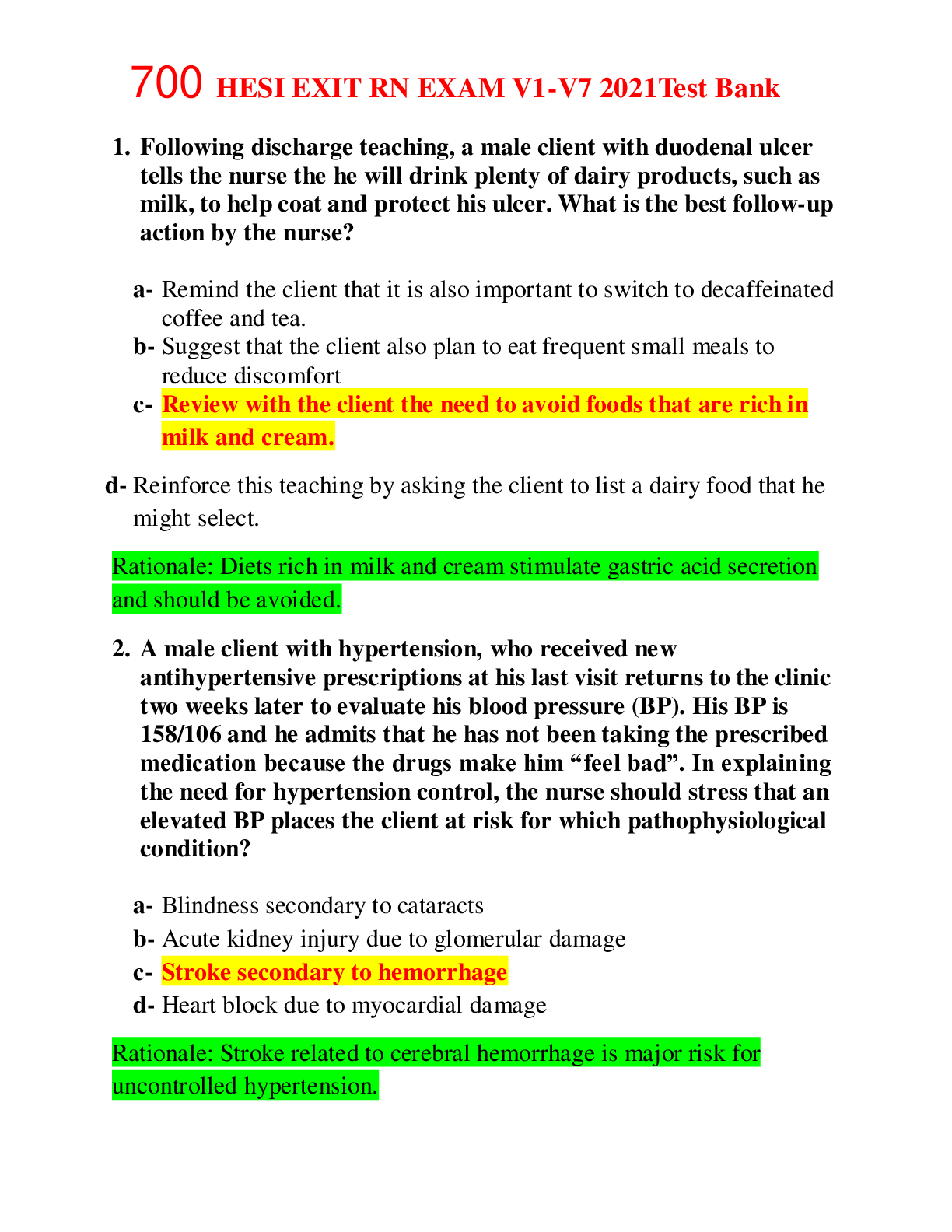

.png)

